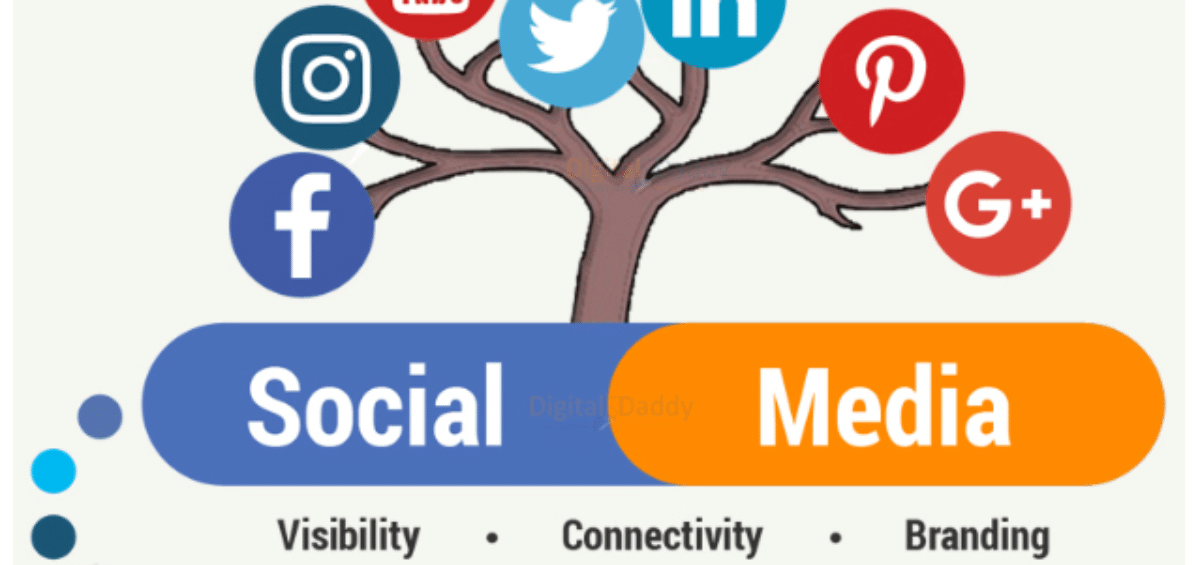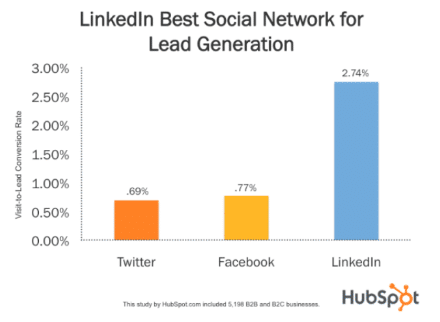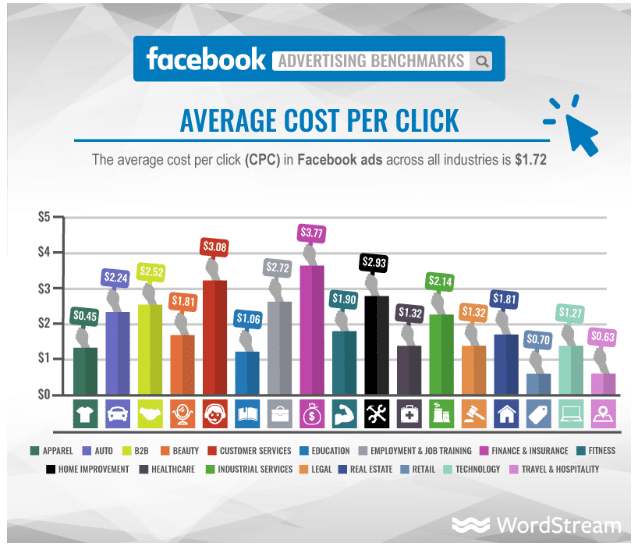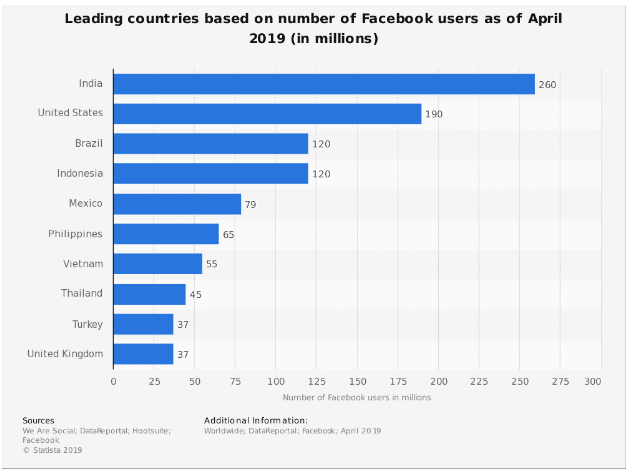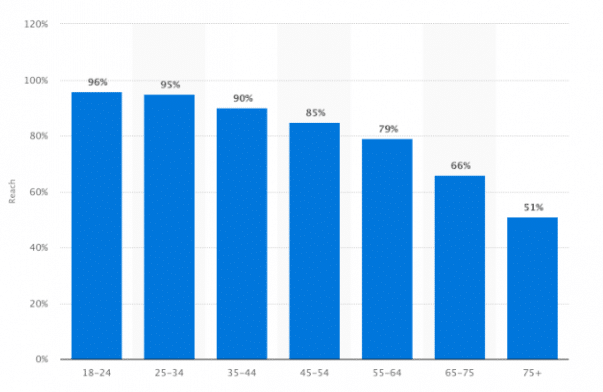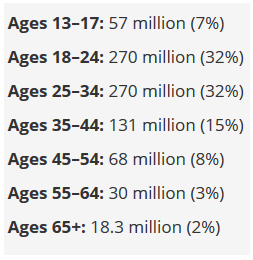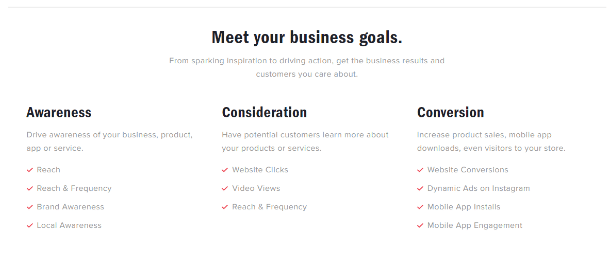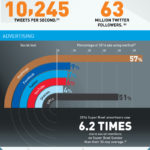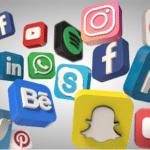97% of social advertisers say Facebook is the best social media for business platform (source). The social media platform has more than two billion active users, and three quarters of them access the site on a daily basis. Out of the 70% of social marketers who say Facebook is the most useful in achieving marketing goals, 83% of them invest in Facebook ads.
But hold your horses for a sec! Before you head over to Facebook to invest your social media for business marketing budget, you may want to take a close look at other social media platforms, like Instagram. It has a billion users and a higher engagement rate than Facebook. Ad spending on Instagram is higher when compared to Facebook too. In 2018, profiles on the platform enjoyed a cool 17%-33% follower growth rate.
So, which social media for business platform should you use? Well, it all depends on your objective and audience. Keep reading to learn about today’s most popular social media for business platforms. We’ll discuss what each platform specializes in along with their pros and cons.
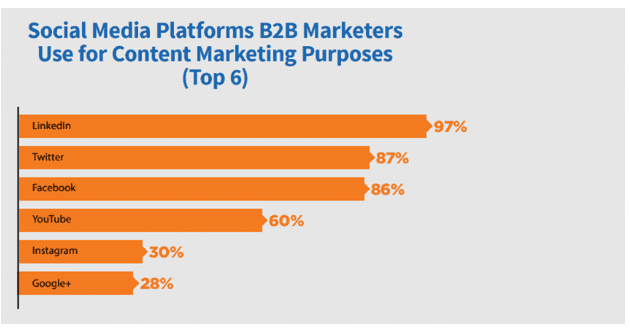
LinkedIn generates 80% of all social media B2B leads. And while Facebook, Twitter and LinkedIn generate 90% of all social traffic to B2B blogs and websites, the latter generates half of that traffic.
89% of B2B marketers already include LinkedIn in their digital marketing mix. Are you one of them?
LinkedIn Demographics
100 million people from the United States use LinkedIn. More than half of these people are male, and 67% of all members fall within the age range of 25 to 54. The largest age group on the platform is 35 to 54.
75% of people on LinkedIn work for companies with more than 1,000 employees. The two industries represented the most on the platform are finance and medical. The education and high-tech industries fall close behind.
Probably the most notable factor about the LinkedIn audience is that 48% of members work in decision-making roles. Ultimately, LinkedIn gives you a prime opportunity to market your message to the people who have the say-so in whether to make a purchase.
Pros and Cons of LinkedIn Marketing
LinkedIn doesn’t require you to pay to play. As long as you share quality content on the platform, LinkedIn will put it in front of a massive audience. The platform even shows it to those outside of your connections on the site. Controversial content performs really well on the platform, which is great for striking up conversations with potential leads.
The platform is leaps ahead of Facebook when it comes to connections. You can only have 5,000 connections on Facebook. With LinkedIn, you can have 30,000. Plus, your LinkedIn wall updates appear for much longer than what your audience sees on Facebook. This gives you the ability to gain a lot of traction out of a single piece of content on LinkedIn.
On the downside, LinkedIn only proves of advantage to B2B marketers. You won’t have much luck targeting young generations who haven’t started a career. And if you choose to pay to play on LinkedIn, it tends to be more expensive than other social media for business sites. To top it off, there are lots of undisclosed rules on the platform. The most innocent of posts are removed without any explanation.
We’ve already covered several reasons to market on Facebook. It’s the most popular social networking site and works well for B2C marketing. 74% of Facebook users log in first thing in the morning and check the platform right before going to bed. It’s the first thing they see waking up and the last thing they see before going to sleep. Facebook is definitely ingrained into our daily lives.
To get the most out of Facebook, you need to understand when and how your audience uses the platform. 96% of Facebook users use their mobile phones to access the site. 43% turn to Facebook as their primary source for news and content.
The average cost per click on the site is $1.72. However, this dollar amount varies across industries.
Facebook Demographics
13% of active Facebook users are women who fall into the age range of 25 to 34. The highest concentration of users is between the ages of 18 and 44. The largest demographic group on the site is men between 25 and 34 years of age.
As surprising as it seems, the highest number of Facebook users aren’t in the United States. India actually has the largest user number (300 million). The US has only 210 million users. This is of particular importance if you sell products or services to customers in India.
Pros and Cons of Facebook Marketing
The pros of Facebook marketing are large in number. You have a massive audience to market to, along with advanced targeting options. You can even take advantage of Facebook retargeting.
Another benefit of Facebook marketing is its low monthly minimum cost. You can deploy marketing campaigns with a budget of only $1 per day. Additionally, Facebook gives you a way to build trust with your audience. It provides a two-way form of communication. You can interact with customers, which goes a long way in improving customer loyalty.
As far as cons, there are a few to consider. First, there’s a lack of organic views. Facebook’s algorithms hinder the visibility of brand messages. And when we say hinder, that’s exactly what we mean. Only about 8% of your fan base will see your posts. This is much different than how things used to be on Facebook. Basically, if you want a large audience to see your message, you’re going to have to pay for it. And while $1-a-day marketing campaigns do exist on Facebook, they rarely provide a strong ROI.
If you want to market on Facebook, we highly recommend checking out these Facebook marketing success stories.
Twitter is another social platform to consider for your marketing. 88% of social advertisers devote part of their budget toward Twitter advertising. During the 2018 Q1, the platform earned $665 million in revenue. $575 million came from ads, and over half of the ad revenue came from social video ads. The platform has 326 million monthly active users. Over 500 million tweets are made every day on Twitter.
Twitter Demographics
In the US, more women use Twitter than men. In Great Britain, it’s the other way around. Internationally, more men use Twitter. In Japan, 52% of women use Twitter. Of all male users, 53% of them use Twitter for news updates. It’s important to note that 80% of all monthly active Twitter users are not in the US. Of those who do reside in the US, the majority of them live in urban areas.
Pros and Cons of Twitter
Twitter is an excellent platform to generate leads and sales. You can use it to boost brand awareness, create positive opinions about your brand, and act as a major customer support channel.
You’ll enjoy narrow segmentation capabilities with Twitter advertising as well as multiple types of ads to choose from. You can run promoted Tweets, promote your account, or even run a promoted trend. To promote a trend, though, you’ll need a massive marketing budget. The average cost of promoting a trend is right at $200,000 a day!
Twitter has three huge cons when it comes to advertising. It’s hard to prove your ROI for one. You can’t really tell if someone bought from you simply because they clicked on your Twitter ad. The platform also lacks when it comes to analytics, especially when compared to Facebook. And worst of all, users are incredibly likely to miss your ads since the platform is a constant stream of information.
YouTube
YouTube is a social media platform that marketers overlook all too often. This platform is incredibly unique because it’s actually a search engine. It’s a video provider, which makes it great for sharing explainer videos and video ads. The site enjoys 1.9 billion monthly active users. It works in 80 different languages and has local versions for 91 countries. This means YouTube reaches an amazing 95% of global internet users. And while there’s no lack of American users, you’ll find it surprising that only 15.8% of all YouTube users are American.
According to research, more people visit YouTube than any other site on the internet except for Google. This ranking for YouTube holds true both inside and outside of the US.
70% of all YouTube views occur on a mobile device. In 2018, the YouTube app was the most popular iOS app. The platform reaches more Americans between the ages of 18 and 34 than any network on TV.
YouTube Demographics
Half of all American internet users who are 75 years old or older use YouTube.
Out of all Americans between the ages of 18 and 44, 90% of them use YouTube. Both Millennials and Generation Z’ers continue to increase their usage of YouTube. 70% of Millennials watch YouTube videos to learn how to do something.
YouTube attracts the most visitors from the US (18.5%), India (8.2%), Japan (4.7%), Russia (4.5%), and China (3.4%). More than half of all YouTube users are female. Also interesting is that the majority of YouTube users have children.
Pros and Cons of YouTube Advertising
No doubt about it, video marketing rules. And since YouTube centers around video content, it makes it a great platform to advertise on. It’s important to keep your video ads short. About 44% of people watching a video will abandon it after 60 seconds. Your message must be easy to digest with a clear call-to-action. When carefully-curated, YouTube videos provide the ultimate way to appeal to your audience on an emotional and touching level.
Another notable advantage of YouTube marketing is that it improves your SEO rankings. Google owns YouTube. It makes perfect sense that Google wants YouTube to perform well. And with Google sitting as the most popular search engine, marketers must do what they can to improve their search engine rankings on Google. To boost SEO with YouTube, follow these tips:
- Create compelling videos with catchy thumbnails.
- Optimize the video’s title and description with keywords. The same applies to the file name of the video.
- Always include your target keyword in the auto-complete feature of a video.
As with any social platform, YouTube marketing comes with a few cons. First, some people find video ads on YouTube to be extremely annoying. And worst, your videos very well may have ads in them from your competitors. So while you’re trying to convince your audience to purchase from you, a competitor may steal your leads right out from under you.
It’s also hard to keep people from illegally downloading your content on YouTube and posting it as their own. There’s also the downside of long wait times. During periods of high-traffic bursts, people often click out of videos. Your audience may choose to abandon your video if it takes a long time to buffer.
Last on our list of social media for business platforms is Instagram. 35% of US adults use this Facebook-owned platform. More than two billion “likes” take place every day on the platform and more than 100 million photos and videos are uploaded daily. Brands across all verticals have found Thursday to be the best day to post ads on Instagram.
Instagram Demographics
Check out the pic below for a clear overview of Instagram’s age-demographic stats.
The most active users on Instagram are between the ages of 18 and 29. 55% of those users check the platform via the Instagram app once a day. If you market your product or service to teens, Instagram is like the Holy Grail of high ROIs. 24% of teens say the platform is their preferred social media site.
Pros and Cons of Instagram Marketing
Instagram gives you the ability to perform detailed targeting. You can target by location, interests, customer behaviors, and demographics. With list-based retargeting, you can ensure your ads are seen by the right audience. This social media for business platform also provides 11 campaign goals along with unique ad formats.
A notable downside of the platform is its limited audience. If you want to target older adults, Instagram marketing won’t provide a high ROI. Instagram isn’t for text-heavy advertising either. And like most forms of social marketing, Instagram advertising is time-consuming. Constant monitoring and interacting with the ads are key to campaign success. However, despite the downfalls, there are many ways to improve your instagram marketing performance.
Need help choosing which social media platform is best for your business? Contact IGW today. We can help you create strategic marketing campaigns for any social media for business platform.

